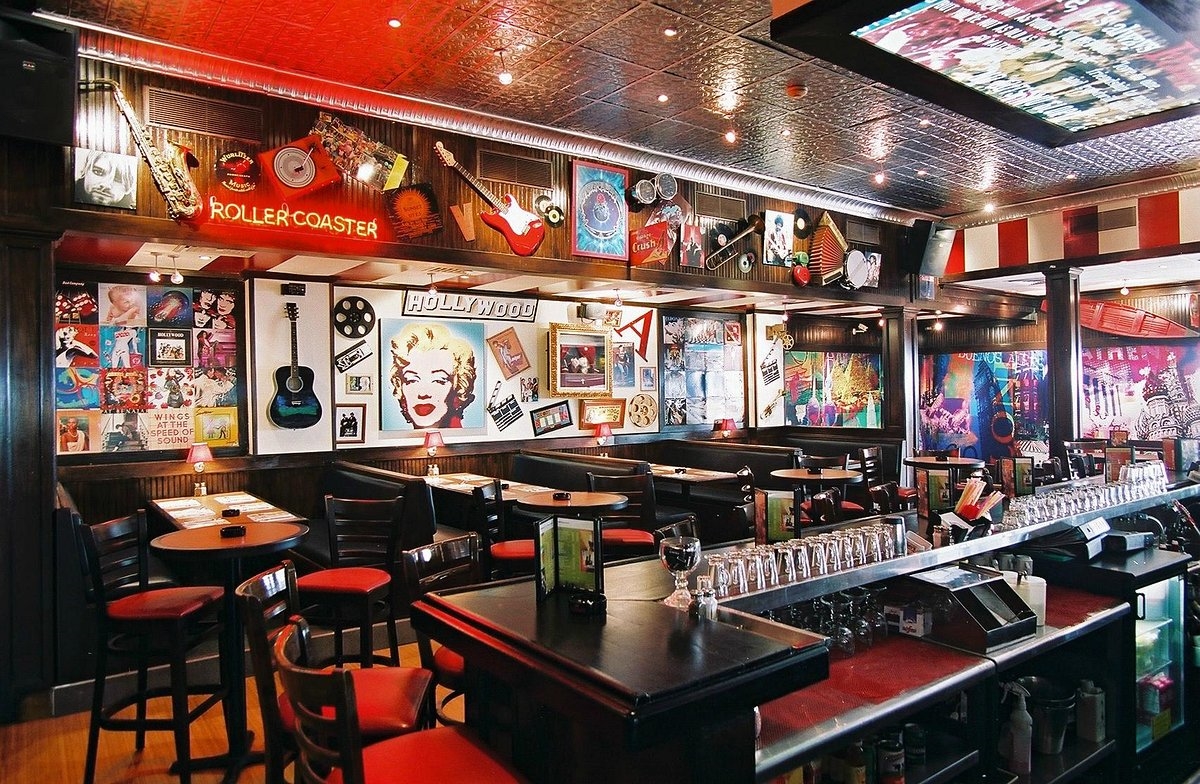This fall, the TGI Fridays chief financial officer, operations chief, general counsel and head of procurement quit.
“We can no longer, in good faith, continue to be employed by the company and risk our own personal liability for the company’s further operations and obligations,” the four executives wrote in a letter to the board, a copy of which was viewed by The Wall Street Journal.
The company filed for chapter 11 bankruptcy in November. It vacated its longtime Dallas headquarters and is storing over 200 boxes of documents and computer equipment at the homes of some employees, according to bankruptcy court documents.
The unraveling of a chain that defined happy hour and family dinner out across America is an epic business saga that spans four CEOs, dozens of restaurant closures, bungled refinance attempts and unpaid bills that no Long Island iced tea could cure.
Its U.S. restaurant count has dwindled to less than 200, including 39 locations that are bankrupt. Complex financial plans by private-equity investors to try to stabilize the company backfired when Fridays couldn’t meet certain obligations during the pandemic and beyond. Franchise owners became so frustrated with the lack of communication and direction from company leaders that some stopped paying royalties, franchisees and their advisers said.
The chain that once said “in here, it’s always Friday” has seen better days.
Ray Blanchette, though, isn’t giving up. Blanchette got his start at Fridays as a restaurant manager-in-training in Philadelphia. He rose to become chief executive of the company from 2018 to 2023, a time when the chain’s candy-colored drinks and specials propelled its bar scene. Blanchette, who currently owns eight Fridays locations, says he knows what it takes to bring TGI Fridays back.
He says the brand’s bet on people wanting to end the week by unwinding with a pint of beer, friendly company and comforting, American food is solid. He is trying to buy up bankrupt TGI Fridays and has made a bid to manage key aspects of the parent company’s finances.
“This isn’t rocket science. You have to sell people a good time,” Blanchette said, as he was in Dallas working to square up his offer to buy restaurants earlier this month. “We sell experiences, not groceries.”
Of the many chains laid low in a bleak year for the more than $1 trillion restaurant industry, TGI Fridays’ decline may be the most tortured. Restaurant companies and operators this year have declared the most bankruptcies in decades outside of 2020, when the pandemic upended the industry, according to BankruptcyData.com records. Red Lobster and Rubio’s Coastal Grill are among them.
Sit-down chains like TGI Fridays have it tougher than most. Families these days are often more likely to eat fast food in their cars than slide into booths to pore over laminated menus. Teens order delivery off their phones, while mom and dad are cooking more at home. Even first dates are less likely to take place at bars and restaurants, surveys show.
A Texas bankruptcy court will now decide aspects of TGI Fridays’ fate, including Blanchette’s plans to buy up some TGI Fridays restaurants through an auction among bidders slated for this month. He’s discussing a broader role in managing the company’s revenue streams and the debt they back, according to bankruptcy filings.
Pioneering the singles bar
New York restaurateur Alan Stillman opened the first TGI Fridays in 1965 in Manhattan as one of the first singles bars. Businessman Dan Scoggin, who started as a franchisee and later served as the chain’s CEO for 15 years, is credited with developing signature touches, such as its Tiffany-inspired lamps, memorabilia on the walls and bartenders who flung their cocktail shakers in the air while making drinks. They held bartender Olympics to compete for the most elaborate mixologist style.
Fridays went public in 1983, but quickly reverted to private ownership again in 1989 when hotel conglomerate and investor Carlson Companies bought the chain for around $52 million. Carlson, the parent of the Radisson hotel chain, said at the time it planned to keep Fridays as it was, then operating roughly 150 restaurants in the U.S., U.K. and Mexico.
Growing up working on a sweet potato farm and nursery in Maryland, Blanchette met a TGI Fridays vice president on a plane who opened the door to call him anytime. Blanchette was working as a food and beverage director of a Sheraton hotel in Newark, Del., and when he eventually called his fellow flier, they met up within hours. Blanchette accepted a job at TGI Fridays and quit the hotel that day.
Blanchette started working at Fridays in 1989 as a manager-in-training in Philadelphia. He was 23 and about to be a dad, and it was peak Fridays. The year before, Tom Cruise had channeled the chain’s vibe with his shaker-juggling tricks in the blockbuster film “Cocktail”; some scenes were filmed at TGI Fridays’ Upper East Side location in Manhattan.
“The casual-dining sector I grew up in was bursting at the seams,” said Blanchette, now 58. He’s married, lives in Houston and has four grown children. “When someone got up to leave, I wanted another butt pushing down in that seat.”
Blanchette’s restaurant pulled in 2,000 guests a day and $140,000 in weekly sales. He rose through the company’s ranks, eventually heading its European division and leading operations. He left in 2007 to head up a holding company for casual-dining companies, but came back as CEO in 2018.
Fridays’ domestic sales peaked in 2008, with $1.97 billion in U.S. revenue across 600 locations, according to market-research firm Technomic. In part through franchise and licensing deals, the brand expanded into 60 countries and generated $2.7 billion globally in 2013.
TGI Fridays soon began to feel pressure: Its U.S. sales slid through the 2010s, and in 2017 were 36% below 2008’s level. Casual-dining chains generally were losing customers to newer fast-casual restaurants, such as Chipotle Mexican Grill, where customers ordered fresh food at the counter and could take it to-go.
Carlson in 2014 sold the chain to private-equity firms Sentinel Capital Partners and TriArtisan Capital Partners in a deal that valued Fridays at around $800 million. It had some 900 owned and franchised restaurants globally, employing 70,000 people.
Its new owners sold off company-owned restaurants to franchisees to help reduce debt, disposing of most locations by 2015. By that year, TGI Fridays’ U.S. sales had declined 24% from 2008 levels to $1.5 billion, and its domestic store count had sunk to 480, Technomic said.
Mounting problems
Blanchette cycled through a series of restaurant-chain executive positions before the company’s financial managers and some franchisees called him in 2018 to ask him back to TGI Fridays as CEO – “my dream job,” he said at the time.
Blanchette bought franchised restaurants that needed attention. He refreshed the menu with whiskey-coated steak and $10 cocktails promising big flavors. When the marketing department asked Blanchette to go on hit reality TV show “Undercover Boss” in 2019 to promote TGI Fridays, he donned a wig and layers of makeup to visit restaurants as “Keith,” a trainee.
Visiting restaurants in disguise, Blanchette found a lot that needed improvement.
“Repairs and maintenance get bottlenecked at corporate,” he said after a Maryland TGI Fridays bartender showed him where the ceiling had collapsed due to a flood. “Something in the chain is broken.”
By then, the company’s finances had also grown precarious. The earlier push to sell off TGI Fridays’ restaurants reduced the company’s debt, but left it with fewer assets for collateral in the event of future distress, according to credit-ratings firm Moody’s Investors Service.
TGI Fridays borrowed $450 million in 2017 in a transaction known as whole-business securitization, which was meant to lower the company’s borrowing costs by using its assets that have cash flow to back its debt. Fridays issued these bonds backed and funded by its franchisee royalty payments. Domino’s Pizza, Dunkin’ and other chains also adopted the practice in the 2000s and 2010s.
One condition of the financing was that TGI Fridays committed to hit at least $1.5 billion in yearly sales. If the company defaulted on those deal terms, investors in the deal could claim TGI Fridays’ royalties and other cash flows going forward.
Cracks started to show the next year, when S&P Global Ratings lowered its view on TGI Fridays’ debt after seven quarters of same-store sales declines and one of the lowest ratios of funds available to pay down debt among similar companies considered by the ratings agency.
Sentinel Capital pulled out of its TGI Fridays investment in 2019, leaving TriArtisan as the majority backer. Then, in 2020, the pandemic struck, shutting down dining rooms and cutting off Fridays’ main source of business.
Blanchette and company executives threw up tents in parking lots to serve to-go food and cocktails. Sales rebounded and the company closed fewer restaurants during the pandemic than Blanchette originally predicted. But total sales still trailed the level required by the company’s securitization deal in 2020, triggering financial consequences. Millions of dollars in royalties and other payments over subsequent years went to the company’s debt investors instead of supporting the brand.
In May 2023 Blanchette resigned as CEO, later buying seven company-owned Fridays locations in the Northeast, and focused on running them.
By 2023, TGI Fridays was down to 269 U.S. stores and $728 million in annual sales from them. Same-store sales at U.S. company and franchised restaurants fell 9% and 7.1%, respectively, that year. Sales had stagnated since 2022, S&P said.
Revolving leadership
The company shuffled through CEOs. Some attempts to refinance debt or explore bankruptcy didn’t pan out.
In April, TriArtisan announced a lifeline: It laid out a plan for TGI Fridays to merge with its largest U.K. franchisee, Hostmore, to go public on the London Stock Exchange. The roughly $220 million deal would stabilize the chain’s finances and revitalize the brand, then doing $1.4 billion in total global annual sales, the company said at the time.
But by June, TGI Fridays’ independent auditor warned that the chain was running out of funds to meet its debt obligations.
“When a capital structure dictates the business, versus the wants and needs of the guest, the business model doesn’t work,” said Daniel Halpern, a veteran Atlanta-based TGI Fridays operator who owns around 22 locations.
Fridays’ CEO left in August. In September, TGI Fridays fell short of its obligations under its agreement with the lenders in its 2017 securitization deal, according to S&P. Shortly after, Hostmore backed out of the merger. Four top company executives quit through a letter sent to the board soon after. TGI Fridays filed for Chapter 11 bankruptcy protection.
Blanchette put out signs in front of his restaurants to let customers know they were locally owned and still running.
Blanchette says he looks at the steady business Fridays still does in airports and casinos and sees a sturdy brand that needs a change in narrative. In early December he submitted a $30.5 million bid to buy nine of the 39 bankrupt TGI Fridays, including the lucrative Dallas-Fort Worth International Airport locations. He’s also held discussions to manage the company’s securitization debt entity, according to a filing.
A bankruptcy court could consider other bidders for the bankrupt restaurants, but Blanchette remains committed to his goal for TGI Fridays.
“I’ve spent the vast majority of my career here. It’s an entire body of work. I don’t want to see the brand go away,” Blanchette said as he waited Monday to see if his bid would be the winner.



